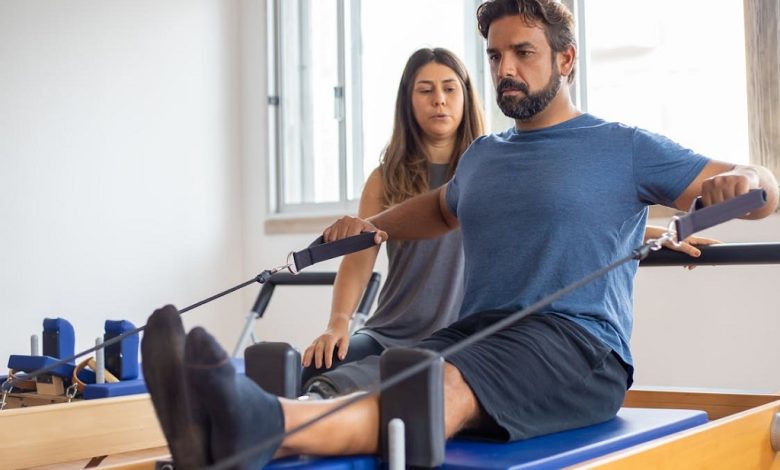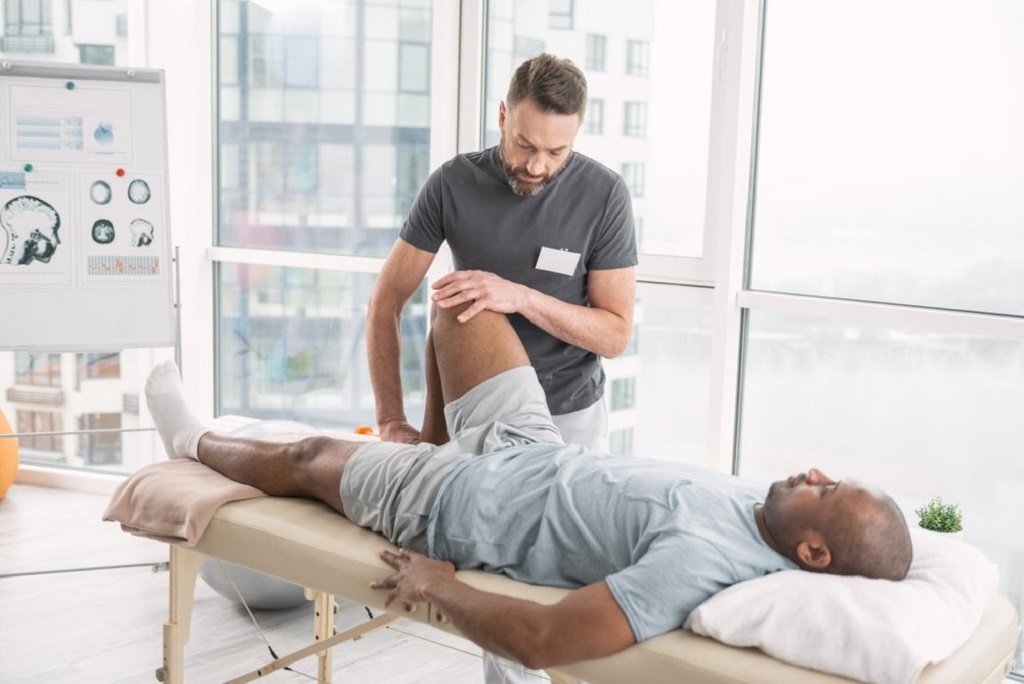The Role of Physical Therapy in Recovery: From Injury to Mobility

Physical therapy changes lives. Imagine waking up unable to walk after a car accident or struggling to lift your arm following shoulder surgery. Then, weeks later, you move freely again—thanks to skilled hands, targeted exercises, and a clear plan. That miracle rarely happens alone. Physical therapy bridges the gap between injury and complete mobility.
In the United States alone, more than 36 million injuries require medical treatment each year, according to the National Safety Council. Meanwhile, a 2023 systematic review in the British Journal of Sports Medicine showed that early physical therapy can reduce the need for surgery by up to 60% in certain musculoskeletal conditions. These numbers prove one thing: structured rehabilitation works.
What Is Physical Therapy and How Does It Help Recovery?
Physical therapy (PT) is a healthcare profession that uses movement, manual techniques, and education to restore function and reduce pain. Therapists treat everything from sports injuries and post-surgical recovery to chronic conditions like arthritis or neurological disorders such as stroke.
Unlike passive treatments that only mask symptoms, PT actively rebuilds your body. Therapists assess movement patterns, strength deficits, and flexibility issues. Then they create personalized programs that speed healing, prevent complications, and help you return to daily life stronger than before.
Why Early Physical Therapy Matters After Injury

Timing changes everything. Starting rehabilitation within the first 72 hours after acute injury dramatically improves outcomes.
Research published in the Journal of Orthopaedic & Sports Physical Therapy (2024) found that patients who began PT within one week of ACL reconstruction regained range of motion 40% faster than those who waited three weeks. Early intervention controls swelling, maintains joint mobility, and prevents scar tissue from forming rigid patterns that limit movement later.
Moreover, early PT reduces the risk of chronic pain. When tissues heal in shortened or weakened positions, the nervous system can “learn” pain as the new normal. Skilled therapists interrupt that cycle before it becomes permanent.
Key Benefits of Physical Therapy During Recovery
Patients experience multiple advantages when they commit to rehabilitation. Here are the most important ones:
- Faster return to work and sport – Structured programs cut recovery time significantly.
- Reduced need for pain medication – Movement and manual therapy lower opioid reliance.
- Lower risk of re-injury – Stronger muscles and better coordination protect healing tissues.
- Improved mental health – Achieving small wins boosts confidence and fights depression common after injury.
- Cost savings long-term – Preventing surgery and chronic issues saves thousands.
A 2023 study from the American Physical Therapy Association revealed that every $1 invested in outpatient PT saves $5–7 in future medical costs.
Common Injuries That Respond Best to Physical Therapy
Almost every musculoskeletal and many neurological conditions benefit from rehabilitation. However, certain injuries show dramatic improvement:
- ACL and meniscus tears – Pre- and post-surgical programs restore knee stability.
- Rotator cuff tears and shoulder impingement – Targeted strengthening prevents surgery in 70–80% of cases.
- Lower back pain – Specific movement therapies resolve 90% of acute episodes without imaging or medication.
- Ankle sprains – Balance and proprioceptive training cut recurrence rates by half.
- Total joint replacements – Structured PT starting day one shortens hospital stays and improves long-term function.
- Stroke and spinal cord injury – Neuroplasticity-based therapy helps the brain rewire movement pathways.
Stages of Recovery: How Physical Therapy Guides You Through Each Phase
Recovery follows predictable stages. Skilled therapists adjust treatment to match your body’s healing timeline.
Phase 1: Acute Phase (Days 1–7)
Goals focus on protection and pain control. Techniques include:
- Gentle range-of-motion exercises
- Ice, compression, and elevation guidance
- Basic isometric strengthening
- Education on safe movement
Phase 2: Subacute/Repair Phase (Week 1–6)
Tissues begin laying down new collagen. Therapists introduce:
- Progressive strengthening
- Soft-tissue mobilization and joint mobilizations
- Low-impact cardiovascular exercise
- Gait training if needed
Phase 3: Remodeling Phase (Week 6–12+)
Collagen matures and aligns with stress. Treatment intensifies:
- Sport- or work-specific drills
- Plyometrics and agility training
- Advanced balance and proprioception
- Functional movement screening
Phase 4: Return-to-Activity Phase (Month 3+)
Final preparations ensure safe return:
- High-level strength and power development
- Simulated real-life or sport scenarios
- Gradual exposure to full demands
- Long-term injury-prevention strategies
Evidence-Based Techniques Physical Therapists Use Today
Modern rehabilitation relies on proven methods backed by current research.
Manual Therapy Joint mobilizations and soft-tissue work restore normal glide and reduce protective muscle guarding. A 2024 Cochrane review confirmed manual therapy combined with exercise provides superior pain relief compared to exercise alone.
Therapeutic Exercise From basic isometrics to complex neuromuscular re-education, exercise remains the cornerstone. Blood-flow restriction training, neuromuscular electrical stimulation, and aquatic therapy expand options when traditional loading isn’t tolerated yet.
Dry Needling and Instrument-Assisted Soft Tissue Mobilization These techniques break down scar tissue and trigger points rapidly. Studies show dry needling reduces pain intensity by 50% within 72 hours for many patients.
Neuromuscular Re-Education After neurological injury or prolonged immobilization, the brain forgets efficient movement patterns. Balance boards, whole-body vibration, and mirror therapy help rewire those pathways.
How Physical Therapy Prevents Surgery and Chronic Pain
One of the biggest success stories in modern healthcare is the shift away from automatic surgery for many conditions.
For example, patients with non-traumatic rotator cuff tears who complete 12 weeks of progressive physical therapy avoid surgery 75% of the time (2023 New England Journal of Medicine). Similarly, the majority of lumbar disc herniations shrink naturally when patients follow specific directional preference exercises discovered through the McKenzie Method.
Therapists also catch “yellow flags”—psychosocial factors that predict poor recovery—and address them early. This comprehensive approach stops acute injuries from becoming lifelong disabilities.
Pediatric vs. Geriatric Recovery: Tailored Approaches
Children heal faster but need creative engagement. Play-based therapy, bright clinic environments, and parent education ensure compliance.
Older adults face different challenges—slower tissue healing, balance deficits, and multiple comorbidities. Fall-prevention programs, high-velocity power training, and dual-task exercises help seniors regain independence safely. A 2024 JAMA study showed that prehabilitation before elective surgery in patients over 70 reduced postoperative complications by 40%.
Home Exercise Programs: Your Role Between Sessions
Success depends heavily on what you do outside the clinic. Therapists now use apps and video platforms to track adherence and form.
Effective home programs include:
- Clear written and video instructions
- Progressive overload built in
- Pain-monitoring guidelines
- Scheduled check-ins or telehealth visits
Patients who complete 80% or more of prescribed home exercises recover up to twice as fast.
When to Choose Outpatient, Inpatient, or Home Health Physical Therapy
Location matters. Acute hospital stays often include inpatient rehab focused on basic mobility and safety. Once discharged, patients choose between:
- Outpatient clinics – Best for sports injuries, post-surgical orthopedic cases, and neurological conditions requiring specialized equipment.
- Home health – Ideal for patients with limited transportation or severe mobility restrictions early on.
- Telehealth PT – Growing option for rural patients or follow-up care (especially effective for exercise progression and education).
Real Patient Stories: From Bedbound to Back on the Field
Sarah, a 34-year-old marathon runner, tore her Achilles tendon. Doctors recommended surgery. Instead, she chose a progressive non-operative protocol under a skilled therapist. Twelve months later she completed the Boston Marathon—faster than her pre-injury time.
Mike, a 62-year-old grandfather, fell and fractured his hip. Aggressive inpatient and outpatient therapy had him walking without a cane in eight weeks and playing with his grandchildren again.
These stories repeat daily in clinics worldwide when patients and therapists partner effectively.
How to Find the Right Physical Therapist for Your Recovery
Not all therapists are equal. Look for:
- Board-certified clinical specialists (OCS, SCS, NCS)
- Direct access privileges (no physician referral needed in most states)
- Modern equipment and private treatment rooms
- Clear communication and goal-setting
- Acceptance of your insurance or transparent self-pay rates
Start with recommendations from your surgeon, primary doctor, or trusted friends. Then schedule a discovery visit or phone call.
The Future of Physical Therapy in Injury Recovery
Technology accelerates progress. Wearable sensors provide real-time feedback on gait symmetry. Virtual reality immerses patients in motivating environments. Artificial intelligence helps predict which patients need extra attention before setbacks occur.
Yet the human element remains irreplaceable. Empathetic therapists who listen, adjust, and celebrate small victories drive the best outcomes.
Related Topics: Cheap Pre-Workout Supplements That Work
Conclusion: Take the First Step Toward Full Mobility Today
Physical therapy transforms devastating injuries into temporary setbacks. From reducing pain and swelling in the first days to rebuilding athletic performance months later, skilled rehabilitation guides every step. The evidence is overwhelming: patients who commit to professional physical therapy heal faster, move better, and stay active longer.
Don’t wait for pain to become chronic or function to decline further. Contact a licensed physical therapist today and start your personalized road from injury to full mobility. Your future self will thank you.
Related Topics:
Frequently Asked Questions
How soon after injury should I start physical therapy?
Most patients benefit from evaluation within 24–72 hours. Early gentle movement controls swelling and prevents stiffness. Your therapist decides the exact timing based on injury severity.
Can physical therapy help if I already had surgery?
Absolutely—and it’s essential. Post-surgical rehabilitation protects repairs, restores range of motion, and rebuilds strength safely. Starting the same day or next day after many procedures is now standard.
Is physical therapy painful?
Some discomfort is normal as tissues adapt, but sharp or increasing pain is not. Good therapists work at the edge of your tolerance and adjust immediately if needed.
How many physical therapy sessions will I need?
It varies widely. Simple ankle sprains may resolve in 6–12 visits. Complex spinal cord injuries can require years of ongoing care. Most orthopedic conditions average 12–24 sessions spread over 2–4 months.
Will insurance cover my physical therapy?
Most plans cover medically necessary rehabilitation with a physician referral or direct access. Check your specific benefits, visit limits, and copayments with your provider.



